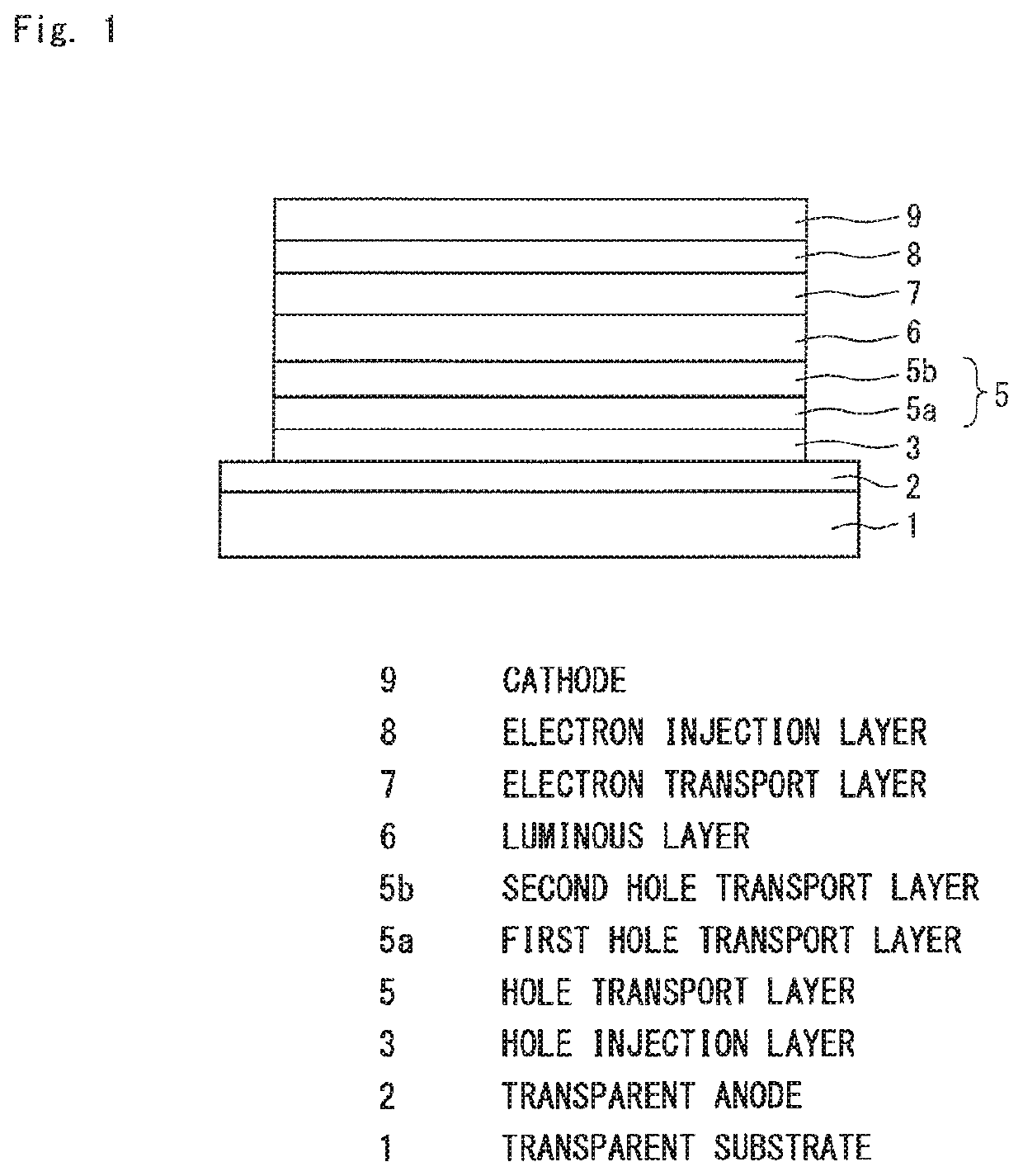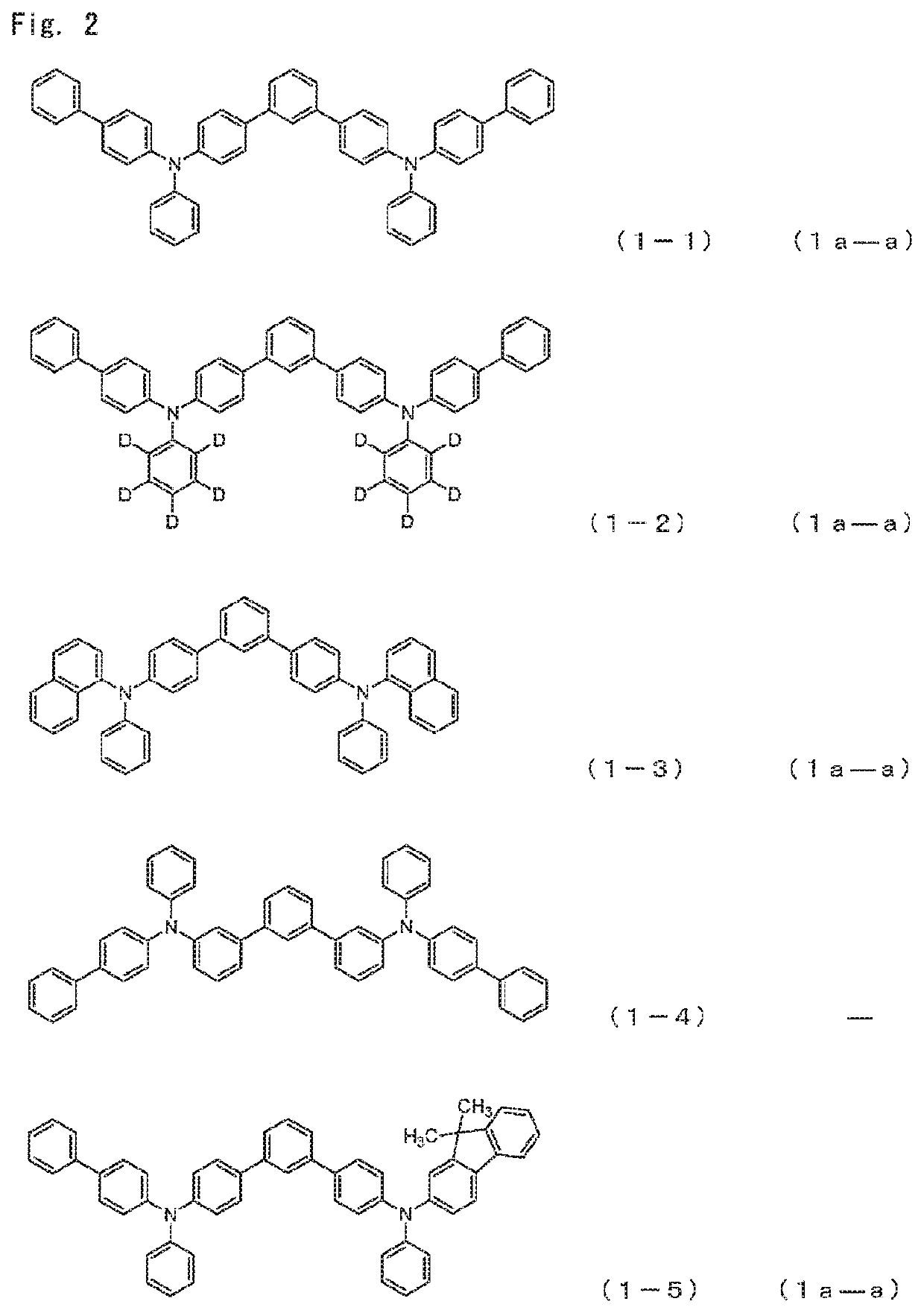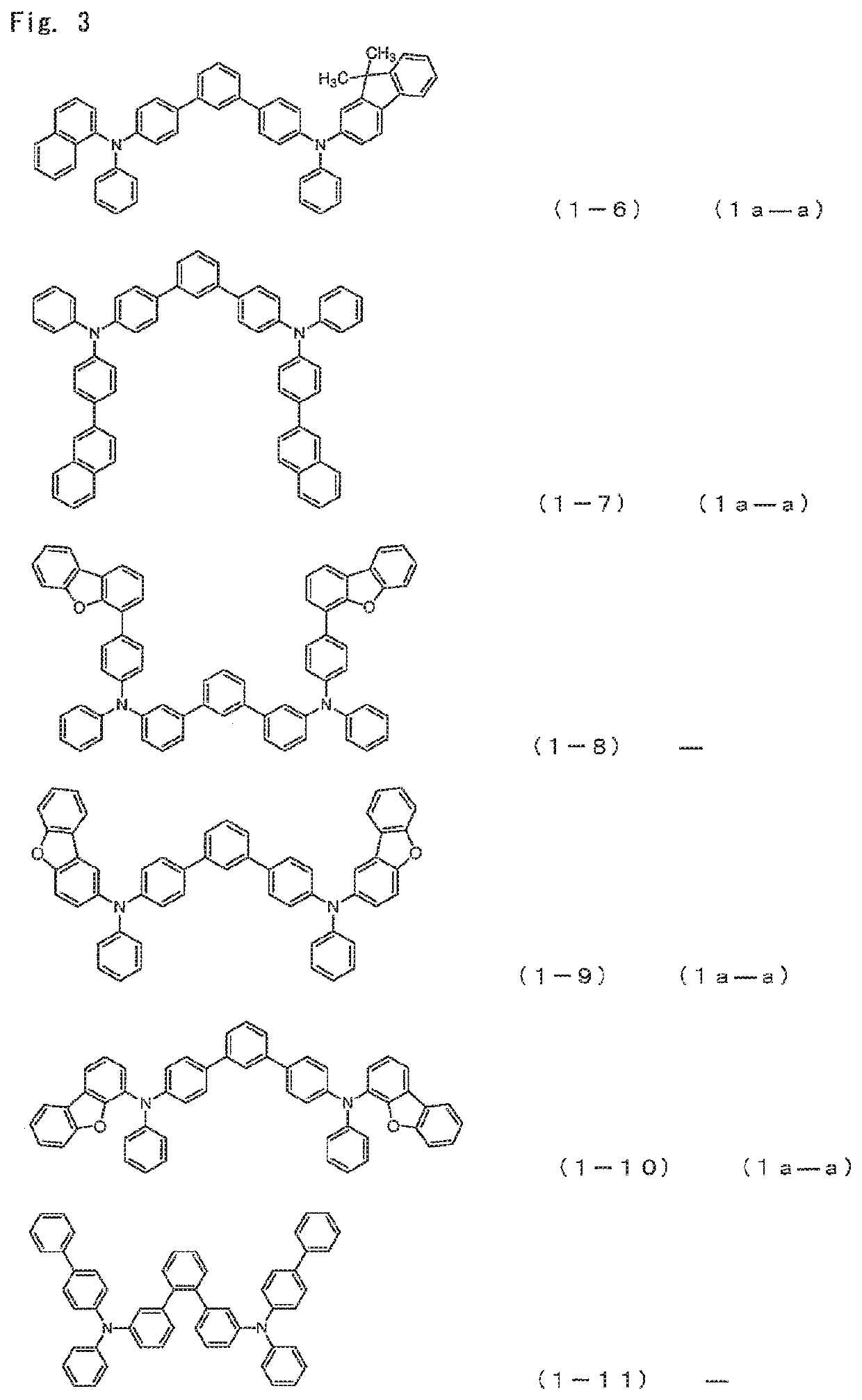Organic electroluminescence device
a technology of electroluminescence and electroluminescence, which is applied in the direction of organic chemistry, indium organic compounds, and platinum group organic compounds, can solve the problems of low heat resistance thermal decomposition, device deterioration, and material deterioration, and achieve the effects of demonstrating the effect of hole injection and transport, effective injection and transportation, and reducing the number of holes
- Summary
- Abstract
- Description
- Claims
- Application Information
AI Technical Summary
Benefits of technology
Problems solved by technology
Method used
Image
Examples
embodiment
Preferred Embodiment
[0168]Among the arylamine compounds of the general formula (1), from the standpoint of stability of a thin film, the arylamine compound represented by the following general formulas (1a-a), (1a-b), (1b-a), (1c-a), or (1c-b) is preferred.
[0169]
[0170]wherein,
[0171]Ar1 to Ar4 have the same meaning as that defined in the aforementioned general formula (1).
[0172]As the Ar1 to Ar4, aromatic hydrocarbon groups are preferred, and among them, a phenyl group, a biphenyl group, a naphthyl group, and a fluorenyl group are preferred.
[0173]When the aromatic hydrocarbon groups or aromatic heterocyclic groups represented by Ar1 to Ar4 have a substituent, a deuterium atom, an alkyl group having 1 to 6 carbon atoms, an alkenyl group having 2 to 6 carbon atoms, or an aromatic hydrocarbon group are preferred as the substituent, and a deuterium atom, a phenyl group, a biphenylyl group, a naphthyl group and a vinyl group are more preferred. An embodiment is also preferred in which the...
example 1
Compound 1-5
Synthesis of 4-{(biphenyl-4-yl)-phenylamino}-4″-{(9,9-dimethyl-9H-fluoren-2-yl)-phenylamino}-1,1′:3′,1″-terphenyl
[0527]
A nitrogen-purged reaction vessel was charged with8.0g,N-(biphenyl-4-yl)-N-(4-bromophenyl)anilineN-(9,9-dimethyl-9H-fluoren-2-yl)-N-{3′-(4,4,5,5-11.4g,tetramethyl-[1,3,2]dioxaboran-2-yl)biphenyl-4-yl}anilinepotassium carbonate7.5g,water64ml,toluene64ml,ethanol16ml, andtetrakis(triphenylphosphine)palladium0.8g.
The mixture was heated and stirred for 16 h at 70° C. After cooling to room temperature and adding ethyl acetate and water, an organic layer was collected by a fractionation operation. The organic layer was concentrated and then recrystallized by using a mixed solvent of THF / acetone. As a result, 9.54 g (yield 69%) of a white powder of 4-{(biphenyl-4-yl)-phenylamino}-4″-{(9,9-dimethyl-9H-fluoren-2-yl)-phenylamino}-1,1′:3′,1″-terphenyl (Compound 1-5) was obtained.
[0528]
[0529]The structure of the resulting white powder was identified using NMR. In 1H-...
example 2
Compound 1-6
Synthesis of 4-{(9,9-dimethyl-9H-fluoren-2-yl)-phenylamino}-4″-{(naphthalen-1-yl)-phenylamino}-1,1′:3′,1″-terphenyl
[0532]The reaction was conducted under the same conditions as in Example 1, except that
[0533]N-(3′-bromobiphenyl-4-yl)-N-(naphthalen-1-yl)aniline was used instead of
[0534]N-(biphenyl-4-yl)-N-(4-bromophenyl)aniline and
[0535]4-{N-(9,9-dimethyl-9H-fluoren-2-yl)-phenylamino}-phenylboronic acid
was used instead of
[0536]N-(9,9-dimethyl-9H-fluoren-2-yl)-N-{3′-(4,4,5,5-tetramethyl-[1,3,2]dioxaboran-2-yl)biphenyl-4-yl}aniline. As a result, 7.88 g (yield 62%) of a pale yellowish white powder of 4-{(9,9-dimethyl-9H-fluoren-2-yl)-phenylamino}-4″-{(naphthalen-1-yl)-phenylamino}-1,1′:3′,1″-terphenyl (Compound 1-6) was obtained.
[0537]
[0538]The structure of the resulting pale yellowish white powder was identified using NMR. In 1H-NMR (CDCl3), the following signals of 42 hydrogens were detected.
δ(ppm)=7.98 (1H),
[0539]7.98 (1H), 7.92 (1H), 7.84-7.75 (2H) 7.70-6.94 (32H), 1.49 ...
PUM
 Login to View More
Login to View More Abstract
Description
Claims
Application Information
 Login to View More
Login to View More - R&D
- Intellectual Property
- Life Sciences
- Materials
- Tech Scout
- Unparalleled Data Quality
- Higher Quality Content
- 60% Fewer Hallucinations
Browse by: Latest US Patents, China's latest patents, Technical Efficacy Thesaurus, Application Domain, Technology Topic, Popular Technical Reports.
© 2025 PatSnap. All rights reserved.Legal|Privacy policy|Modern Slavery Act Transparency Statement|Sitemap|About US| Contact US: help@patsnap.com



